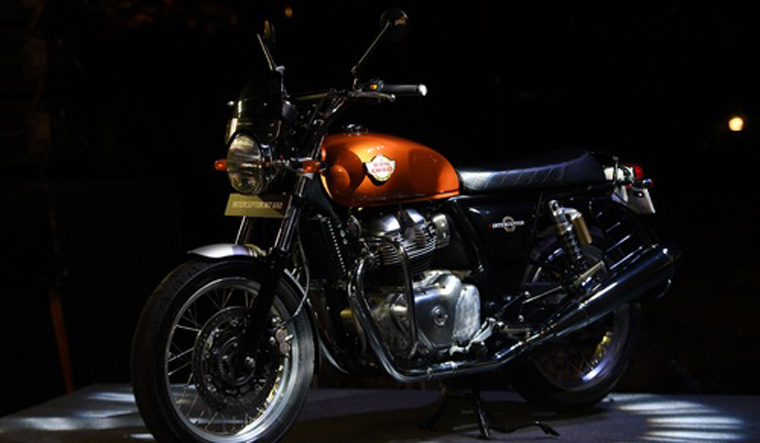Harder, better, faster, stronger. These lines by Daft Punk (recently sampled more famously by Kanye West) best sums up the aspirations of young bike affectionados across India that is fuelling a paradigm shift of sorts in the country's two-wheeler industry, the world's biggest.
Royal Enfield CEO Siddhartha Lal was all breathless with superlatives as he launched the brand's most powerful bikes yet, the Continental GT and the Interceptor, both 650cc. The glitzy event on a cliff overlooking the Arabian Sea in Goa on Wednesday was live streamed to millions of bike lovers across the country and abroad.
The very next day, Jawa, a legendary Czech brand most people have heard of than have actually seen, made a big splash return to India (it was present decades earlier) at an event in Mumbai, launching two 300cc models, with a limited edition third model to be released later. “The whole journey is a sheer result of serendipity...and that gut feeling,” said Anupam Thareja of Classic Legends, one of the partners. The other partner, of course, is Anand Mahindra of Mahindra & Mahindra, the industry giant that has thrown its weight behind this venture.
The more the better when it comes to cc, bhp and every power spec available – that is the new mantra as Indians increasingly go shopping for their bikes. The days of the 100cc, those humble commuter bikes big on mileage (remember taglines like 'Fill it, shut it, forget it?') and just adequate power to beat the rush hour traffic, are surely past their prime.
Regular bikes in the 100-125cc still form the biggest chunk of the one-and-a-half crore bikes sold in India every year, but their growth rate is slowing. Last year, premium bike sales (what constitutes a premium bike is conflicting when it comes to different manufacturers, some put anything 150cc and above as premium while others prefer 250cc and more—a simpler thumb rule is to put all bikes over Rs one lakh as premium) went up more than 20 per cent, much higher than the budget commuter segment. And if you compare growth rates over the years, premium bikes moved up from just 4 lakh six years ago to 14 lakh last year.
Fuelled by rising income levels, globally aware aspirational youngsters (thank you, Internet), this rise in preference for much powerful bikes compared to the no-nonsense 100cc ones have even captured the imagination of the traditional bike manufacturers. Add to this the fact that the margins are higher and scope of growth immense, all the biggie players have naturally turned their attention to this segment.
“This will be the year of the premium,” Marcus Braunsperger, tech head of Hero Motors, the nation's biggest bike maker, had declared at the Auto Expo earlier this year. While Hero toyed with the idea earlier with the 150cc CBZ , it perhaps was ahead of its time. But competitor Bajaj took note and worked at its performance range, coming up a few years later with Pulsar (150 and 180cc). Hero now has a reinvented version of Impulse, called Xpulse and revving at 200cc now in the market. Market sources indicate the company may come up with another premium bike soon which could perhaps even be a 500cc.
Rival Bajaj is shifting its gears even higher—it has tied up with UK-based premium bike maker Triumph, while continuing to have a partnership with Austria's KTM (its long running collab with Kawasaki expired two years ago) and is reported to have new higher cc variants of Pulsar, Dominar and Avenger on the anvil. TVS is also a strong player in the higher category with its Apache RTR—it recently launched a 310cc Apache.
But first, they will have to take on the big daddy of the premium segment of bikes in India. For the longest time, heavy bikes have been synonymous with Royal Enfield, especially its iconic 'Bullet' brand. The company also has other models like the Classic and Himalayan beside the two 650cc models launched this week, and is now gearing up to harvest the impending boom in the segment. “(Indian commuter bike owners) want to upgrade into more authentic forms of motorcycling. I think our form of 'pure' motorcycling allows for that without burning a hole in your pocket and also (lets) you enjoy all the authentic attributes a motorcycle should be having. Those are the things we've been able to do better,”points out Rudratej Singh, president of Royal Enfield.
It's all gung-ho at Enfield, despite the prospect of mainstream biggies entering its territory of higher cc bikes. In fact, so confident is the company on its rising bottomline, that its focus is more on expanding globally compared to tackling impending competition. "When the opportunity is so wide and we are good at this segment, why should we distract ourselves?”, asks Singh, adding, “The growth will come from expansion of the segment, not from snatching the market from someone else.”



